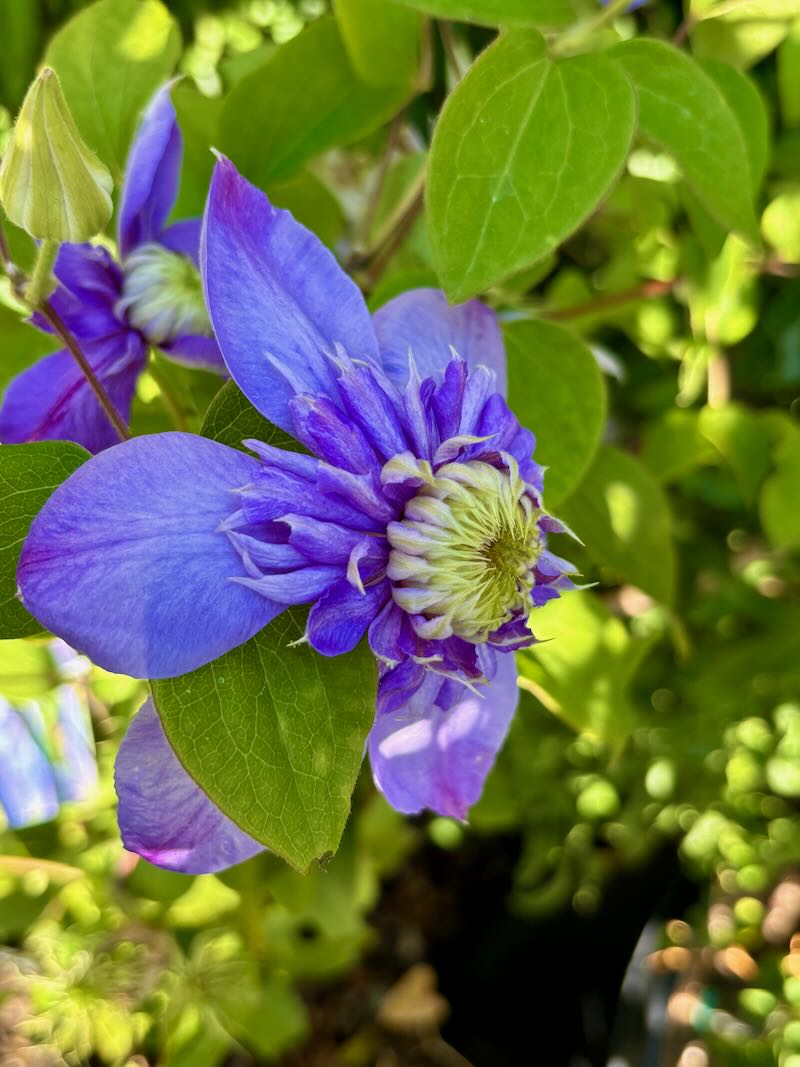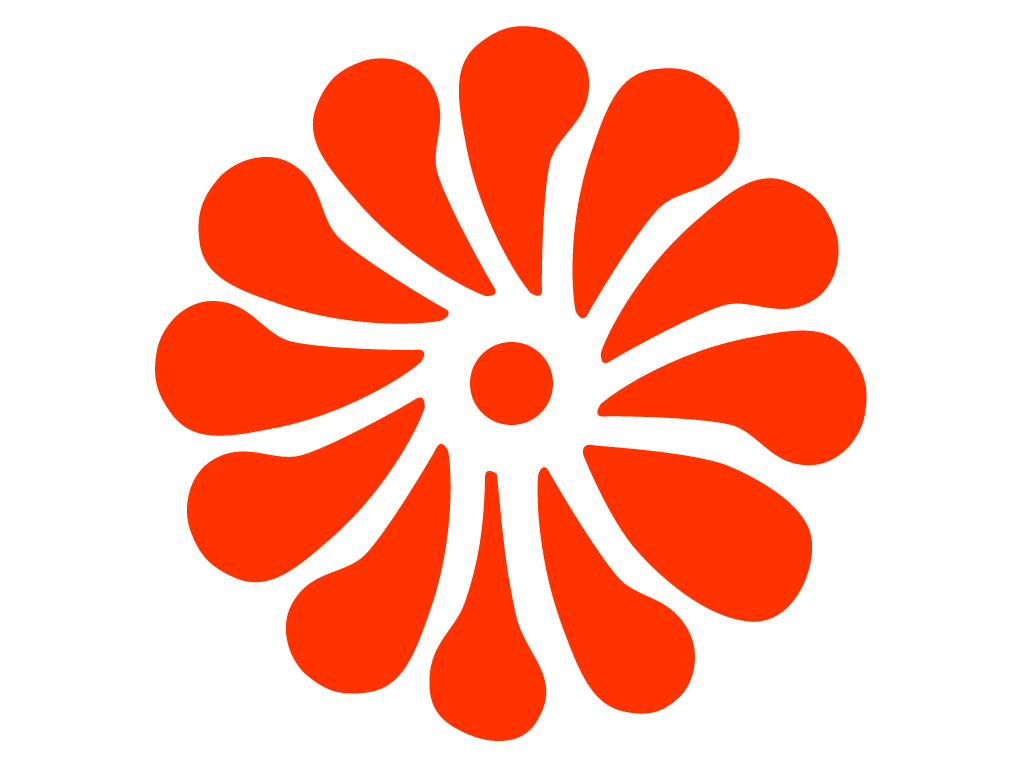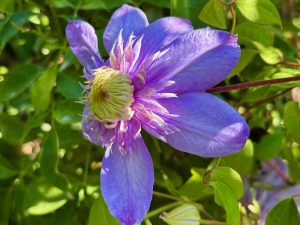Clematis ‘Vanso’ (Blue Light®): double-blue drama for trellises, fences, and containers
Clematis ‘Vanso’ widely sold as Blue Light® Clematis, delivers masses of large, layered violet-blue to pale blue flowers on a compact, eager climber. This showy sport of the classic ‘Mrs. Cholmondeley’ belongs to the Buttercup family, Ranunculaceae, and it brings the best traits many gardeners want in a clematis: generous repeat bloom, a manageable size, and strong garden performance in both borders and pots.
Give it sun on the vines and shade on the roots, and it rewards you with spring doubles that look like ruffled dahlias, then semi-double or full single flowers again later in the season. You can train it on a trellis, weave it through a small shrub rose, or let it sparkle up a patio container. Either way, this is a reliable choice when you want a long, colorful season without a sprawling monster.
Meet Clematis ‘Vanso’
This deciduous climber grows quickly to about 1.8–2.4 m tall (6–8 ft) and 0.9–1.2 m wide (3–4 ft) when given a simple support. Slender leaf stalks twine around wires, netting, or twiggy branches, so you never need heavy hardware. Foliage is mid-green and clean, forming a neat backdrop for the big blooms. In USDA Zones 4–8, it drops its leaves in winter and wakes early in spring. In hot summer districts, a touch of afternoon shade helps it keep flowering. Gardeners also prize ‘Vanso’ for good garden manners: it stays compact, starts early, and reblooms well with light grooming.
Why Blue Light® blooms look so lush
The flowers set the tone. In late spring, Blue Light® Clematis opens fully double blooms, each 12–15 cm across (5–6 in). They carry multiple rows of petaloid segments that build to a domed rosette. As temperatures rise, the plant often shifts to semi-double or single blooms for the second act, still large and luminous. Color runs from soft lavender-blue to a cooler, pale blue, and the tones shift slightly with light and temperature. Even after the petals drop, the silvery, feathery seed heads hang on the vine and catch the light for weeks.
Flowering season you can plan around
Expect the first flush in late spring, often May or June depending on your climate. In cooler regions, bloom can start a bit later but lasts longer. After a short pause, ‘Vanso’ sends a second show in late summer or early fall. In very hot spells, it may rest, then return once nights cool. Light deadheading and a mid-season feed keep the energy flowing to new buds.
Growth habit and where Clematis ‘Vanso’ shines
Because it tops out around 2.4 m (8 ft), Blue Light® Clematis suits small gardens and tight courtyards. Spiral it up a trellis by the front door, or dress a mailbox post. Weave shoots through a compact shrub rose or a small Japanese maple to layer color and texture. In a pot, it becomes an elegant accent for balconies or patios, especially when you underplant with low mounds that shade the crown. The plant tolerates the juglone of Black Walnut and shrugs off urban sites with reflected heat, provided the roots stay cool and evenly moist.
Environmental tolerances worth noting
Heat: the vine handles warm summers if you offer midday or late-afternoon shade.
Cold: hardy to Zone 4 with winter mulch over the root run.
Wind: stems are flexible but can kink if whipped; tie new shoots early.
Soil: adapts to a range of textures as long as drainage is good. Slightly alkaline soils suit it well.
Wildlife: deer usually ignore the foliage; pollinators visit open blooms.
How to Grow Clematis ‘Vanso’
Light
Place the vining growth in full sun to part sun for best flowering. Aim for 6 hours of direct light daily in cool summer regions. In hot, humid zones, give morning sun and light afternoon shade. Keep the root zone shaded by mulch or low plantings.
Soil
Plant it in fertile, moisture-retentive but well-drained soil. A loam enriched with compost works best. Target a pH from neutral to slightly alkaline (about 6.8–7.5). If you garden on heavy clay, build a raised bed 15–20 cm high (6–8 in) and blend in coarse bark, grit, or sharp sand to improve drainage. Avoid waterlogging at all times.
Watering
Water deeply and consistently. After planting, soak the root zone with 10–12 L (2.5–3 gal). Through the first growing season, water whenever the top 2–3 cm (¾–1 in) of soil feels dry. Mature plants need about 2.5 cm (1 in) of water per week in average weather, more during hot spells. Drip or a slow hose soak works better than overhead sprays and keeps foliage drier.
Fertilizing
Feed lightly but regularly. In early spring, scratch a slow-release, balanced fertilizer into the soil at label rates, or top-dress with 2–3 cm (¾–1 in) of compost. After the first flush of bloom, give a half-strength liquid feed high in potassium to support rebloom. Avoid heavy nitrogen, which pushes leaves at the expense of flowers.
Planting and spacing
Dig a broad hole 45–60 cm wide (18–24 in) and about as deep as the pot. Loosen the sides. Set the plant 7–10 cm (3–4 in) deeper than it grew in the container so the crown sits below the surface. That extra depth protects dormant buds should a stem die back. Backfill, firm, and water to settle. Space multiple plants about 90–120 cm apart (3–4 ft) on a fence to give each vine room to show.
Mulching and root cooling
Clematis like “heads in the sun, feet in the shade.” Lay a 5–7 cm (2–3 in) mulch of leaf mold, fine bark, or compost over the root run. Keep mulch 5 cm (2 in) away from stems to prevent rot. Underplant with low perennials—hosta, heuchera, hardy geranium, thyme—to shade the soil and lock in moisture.
Staking and training
Provide a trellis, wire grid, obelisk, or netting at planting. Blue Light® Clematis climbs by wrapping its leaf petioles around slender supports, so aim for rungs or twigs 0.5–1 cm thick (¼–⅜ in). As new shoots extend, fan them out and tie softly with garden twine. Spread stems horizontally where possible; more horizontal shoots make more flowering spurs.
Pruning Clematis ‘Vanso’ (Group 2)
‘Vanso’ flowers on both old wood and new wood, so use a light, timely hand. In late winter or very early spring, remove dead or weak stems down to healthy buds. Then shorten the remaining stems by about one-third to a strong pair of buds at 60–90 cm (24–36 in). After the first bloom, deadhead by cutting faded flowered shoots to the first strong set of leaves. This quick tidy encourages the late-season flush. Avoid cutting the entire plant to the ground, or you will delay bloom and lose the spring doubles that form on mature wood.
Containers and patio culture
Choose a container at least 40–45 cm (16–18 in) in diameter with large drainage holes. Use a high-quality potting mix blended with 20–30% fine bark or perlite for drainage. Slide a slim obelisk or trellis into the pot at planting. Water when the top 2–3 cm (¾–1 in) of mix dries. Feed potted plants a half-strength liquid fertilizer every 3–4 weeks from spring to midsummer. In cold climates, move the pot to a sheltered, unheated space after leaf drop, keep the mix just barely moist, and return outdoors in early spring.
Design pairings that flatter Blue Light® Clematis
Plant Blue Light® Clematis to thread through compact shrub roses like ‘The Fairy’ or a small Acer palmatum for romance without bulk. Pair with silver foliage—Stachys byzantina, artemisia, or lamb’s ears—to make the cool blue petals pop. In a border, combine with catmint, salvias, or daylilies for a long, layered show. Along a fence, alternate with white or blush clematis for a soft, watercolor blend.
Propagation notes for Clematis ‘Vanso’
Layering works well for home gardeners. In spring, bend a flexible, non-flowering stem to soil level, nick the underside lightly, pin it down, and cover the wound with 5–7 cm (2–3 in) of mix. Keep it moist. Roots usually form by autumn; sever and transplant the following spring. You can also take 8–10 cm (3–4 in) soft- or semi-ripe cuttings in early summer and root them in a gritty, sterile medium with bottom heat and bright, indirect light. Note that Blue Light® (‘Vanso’) was protected by a U.S. plant patent; where legal restrictions apply in your region, respect them and purchase plants rather than propagating.
Pests and diseases: identify early, act fast
Clematis wilt (stem rot) can strike fast. Affected stems suddenly collapse and blacken. Cut the wilted stem back into healthy green tissue, sterilizing pruners between cuts. Because you planted the crown deep, dormant buds often push new shoots to replace what you removed. Powdery mildew shows as a gray film on leaves in warm, dry weather with cool nights. Improve air movement, avoid overhead watering, and remove the worst-affected leaves.
Aphids cluster on soft tips in spring; a firm water spray or insecticidal soap controls them. Spider mites stipple leaves during heat waves, especially on container plants; rinse foliage and increase humidity around pots. Vine weevil adults notch leaves; their larvae chew roots in containers. Use sticky barriers and inspect potting mix when repotting. Slugs, snails, and earwigs can nibble petals or young leaves; set simple traps and tidy dense mulch near stems.
Keep the base open to light and air, water at the soil, and clean up fallen petals after big flushes. These simple steps prevent most issues and preserve bloom quality.
Seasonal care calendar
Late winter to early spring: Uncover the crown if mulched heavily, then renew mulch around—but not on—the stems. Prune as a Group 2 clematis: remove dead wood and shorten remaining stems by one-third. Feed with slow-release fertilizer or a compost top-dress. Secure support ties before shoots lengthen.
Spring: Water deeply as growth surges. Guide young stems onto the trellis. Pinch a few tips at 45–60 cm (18–24 in) to encourage branching if the framework looks sparse. Watch for aphids and knock them back early.
Early summer: Enjoy the double bloom. Deadhead by trimming back to strong leaves. In warm regions, give a half-strength high-potash liquid feed. Keep the root zone shaded and moist.
Midsummer: If heat slows flowering, keep watering consistent and foliage clean. Lightly thin congested shoots to improve airflow. Avoid hard pruning now; you want buds for the late show.
Late summer to fall: Second flush often arrives as nights cool. Continue light deadheading. In cold regions, stop feeding about six weeks before your average first frost so stems harden.
Late fall: After leaf drop, tidy the vine, remove any diseased foliage from the ground, and add a loose mulch over the root run 5–7 cm (2–3 in) thick. In very cold zones, protect the crown with extra mulch and a simple windbreak.
Troubleshooting common issues
Few or no flowers: check light first. Increase sun exposure and reduce high-nitrogen feeding. Confirm you did not prune too hard in spring; heavy cuts remove the flower buds that form on older wood.
Flowers fade quickly: hot, dry winds and intense afternoon sun speed petal drop. Shift the site to morning sun and provide a wind lee if possible.
Stems won’t climb: provide thinner supports. Leaf stalks cannot clasp thick timbers; run galvanized wires or stretch plastic netting over posts and let petioles do their job.
Sudden stem collapse: likely clematis wilt. Cut back to clean tissue, disinfect tools, and rely on those deep-planted buds to send replacements.
Container plant droops daily: pot may be undersized or rootbound. Up-pot to at least 40–45 cm (16–18 in) diameter, refresh the mix with a gritty blend, and water more deeply but less often.
Frequently asked questions
Can I grow Blue Light® on a north wall?
Yes, if you get bright open sky and indirect light. Expect fewer flowers than on an east or south exposure, but the blooms may hold their color longer.
Will it smother a small shrub?
Not if you guide it. Thread a few stems through the host and tie the rest to a freestanding trellis so you can manage density.
Is Clematis ‘Vanso’ good for cutting?
Cut stems when the bloom is just opening. Split the stem base and sear quickly, or use floral conditioner; the doubles hold well in arrangements and the seed heads add texture later.
The short list for success
Plant it deep. Shade the roots. Give the vine sun. Tie early. Water deeply. Feed lightly. Prune as Group 2. With that simple plan, Clematis ‘Vanso’ or Blue Light® Clematis delivers elegant, double-blue flowers in spring and a generous encore later on—exactly the kind of dependable show a small garden or terrace needs.



